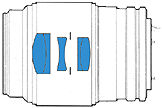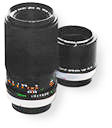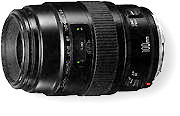 |
A combination of Moderate, size, weight, working distance and perhaps price as well. |
However, stepping up from a 50mm macro lens to the 100mm does present various advantages. First on the list is to increased working (lens-front-to-subject) distance. With that, it is easier to light the subject. The primary reason for using macro lenses is to take close-ups, but as you move closer to the subject, you or the camera may throw a shadow over it, creating poor lighting conditions.
 |
The 100mm Macro eliminates this problem. In addition, this lens is useful when approaching a subject is impossible like in a hazardous situation or obstructed physically. As compared, this lens is still considered compact enough, weighing only 240 grams and other than using it for close-ups, you can alsoput it into good use for general photography as a normal telephoto lens. |
The 100mm Macro has a more natural
perspective characteristics than that of the 50mm equivalent but still shy from it
all as compared with the 200mm. When using a 50mm Macro, moving in too close to the
subject produces image deformation due to the accentuated perspective attributable
to any 50mm lens. Using the longer focal length 100mm Macro for close-up photography
may reduce such phenomenon. Naturally, since the focal length is almost doubles, when
using the 100mm Macro for general photography, it will generates less depth of field
compared with the 50mm Macro for the same focusing distance, but when both are
used at the same magnification in Macro photography, the degree of blur is the same.
(Although the 100mm Macro is lightweight and compact, it weighs nearly twice that
of the 50mm, and its depth of field is much shallower). To use blur effectively,
you must develop a critical eye for the size of the blurred highlights, the tinge
difference between the highlights and shadows and the gradation of such tinges.
The 100mm Macro covers an extremely wide focusing range from infinity to a magnification
factor of 0.5X without requiring an attachrnent. When combined with the FD 50-U extension
tube, close-up shooting over a magnification range of 0.5X to 1X is possible. Of
course, the 100mm Macro can also be used to shoot general photographs due to its
focusing range from the extreme of macro setting which is also extends to infinity.
New FD 100mm f/4 Macro Lens
This lens is designed largely for close-up photography, and the extended shooting
distance it allows gives increased flexibility.
 |
It has a magnification of 0.5X at its minimum focusing distance of 45cm. (The same magnification is produced at a focusing distance of 23.2cm with the 50mm Macro.) Even at the maximum magnification of 1X achieved when the lens is combined.with the FD 50-U extension tube, a extended comfortable film-to-subject shooting distance of 40cm can be maintained. |
This lens is comprised of 5 elements, 3 groups lens construction which also facilitates optimum correction of astigmatism distortions, an all important factor in close-up photography. It also suppresses aberration fluctuations caused by varied shooting distances ranging from infinity to a magnification ratio of 1. A friction mechanism is provided on the focusing ring to prevent the lens barrel from accidentally extending when shooting with the lens pointing down. This is an all-purpose lens which also features general photography capabilities. Its biggest advantage over the longer but even more flexible 200mm macro is its price ( but consider without the need to attach an addtional extension ring, but also at the compromise point of addtional size and weight that adds onto the 200mm lens). The 200mm macro lens dimension is around 182.4mm x 68.8mm and it weighs 880g, while the 100mm featured here is almost half the size, weight and may be halved in its price compared (95mm x 70.3mm and weighing 455g).
NOTE:- Info on the NEWER autofocus version
Credit: Image courtesy of Laura Kornylak ® <shutterblade@comcast.net> from shutterblade*com where the Company has a website on its own. Image copyright © 2003. All rights reserved. Please respect the visual property of the contributing photographer.
 |
Specifications: |
 |
|
Function: Auto Aperture, Full aperture metering (AE operation when used with
ALL Canon automatic SLR cameras.
Length x max. diameter: 95mm x 70.3mm
Weight: 455g.
 |
 |
Older Version: Canon Macro Lens FD 50mm f/3.5 S.S.C. and Canon Macro Lens FD 100mm f/4 S.C. |
 |
Current autofocus version: EF 100mm f/2.8 Macro |
Quick
data for cross reference:
Focal length and maximum aperture: 100mm f/2.8; Lens construction: 10 elements in
9 groups; Angle of view: 24°; Focus adjustment: Front group linear extension
system with micromotor; Closest focusing distance: 0.31 m; Filter size: 52mm; Length
x max. diameter, weight: 105.3mm
x 75mm,
650g.
Canon
EOS SLRs | Canon EF lens Resources
| Back |
Main
Index
Page
of Canon FD lenses
| Back |
Main
Index Page of Canon A & T Series SLR Models
| Message Board |
for your Canon
A-Series SLR camera(s)
| Message Board |
for your Canon
T-Series SLR camera(s)
| Message Board |
for your Canon
T90 SLR camera
| Message Board |
for your Canon
F-1(n) SLR camera
| Message Board |
for your New
Canon F-1 SLR camera
| Message Board |
for your Canon Optics in a shared environment
| Message Board |
Specifically for Dispose or Looking for Canon Photographic Equipment
About this
site...
![]()
Home - Photography
in Malaysia
Copyright
© 2000.
leofoo ®. MIR
Web
Development
Team.
Site
Maintainance Editors: Kaipin, Terry Carraway, Gerry, Winston,
Tom & IRwin (Dr Strangelove); Credit: Richard Yeow, general manager
of Canon Marketing for his continual support;
Mr. Philip
Chong,
who volunteered to be a Maintainer of this site; Mr. Vincent
Thian,
an AP (Associated Press) photographer for contributing
some of the great images appeared in this site; Mr CYLeow, photo-editor
of The Star newspaper for some of his images used; my nephew EEWynFoo for helping so
much of the tedious scanning works. And TO ALL THE CANON GURUS: Thank you for helping
so much with the input of so much of invaluable information at the various Canon
Message Boards. Site
created 'unfortunately again with a PowerMac.